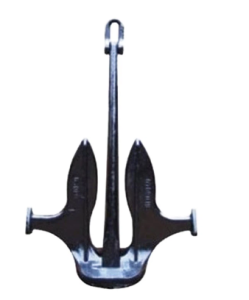- What is marine anchor?
Anchor is a marine device used to hold a vessel in a certain position by restraining the force of movement when anchoring the boat to the bottom of a river or sea. Once anchored, boats cannot be moved to another location by currents or waves.
The type of anchor used on a ship will depend on the type of ship, as well as the use and characteristics of the ship.
According to the structure, people are divided into two types of anchors: anchors with crossbars and anchors without crossbars.
+ Crossbar anchors include Matroxov anchors, Navy anchors, single-blade anchors, multi-blade anchors, specialized anchors, and more.
+ Anchors do not have cross bars like Holl anchors, etc.
- Basic characteristics of ship anchors
Basic characteristics of anchors include geometrical characteristics and structural characteristics of the anchor.
The basic geometric characteristics of anchors include:
- Anchor weight: GN, kg.
- Blade folding angle: β (tilt angle between blade and anchor shaft), degrees.
- Angle of attack: α (angle formed by the direction of the anchor blade and the mud ground), degrees.
- Anchor shaft length: AN, m.
- Anchor blade length, anchor handle thickness, anchor blade thickness and anchor size ratios.
- Structural characteristics of marine ship anchors
- Holl anchor
Anchor Holl is most widely used today on most large and small ships, ocean liners, river and lake ships, etc. Because this type of anchor is highly mechanized, there is no need to prepare the anchor time. When pulling the anchor, the anchor leans against the side with three points (1 point at the base, 2 points at the two blades), disassembly and repair are required. anchor repair is also easy. On the other hand, the use of this type of anchor tends to reduce the anchor length, especially in low-sided ships, Holl anchors are not used up most of the anchor shank length.
Structural features of this type of anchor are that the anchor handle and anchor base are cast separately, the anchor blade can rotate relative to the anchor handle at an angle β = 45°, the two blades can simultaneously cling to the ground.

- Naval anchor
This type of anchor, when released, only sticks to the ground with one blade, while the other blade rotates upward, making it difficult for other ships to move, especially in shallow water. This type of anchor is not mechanized when dropping and when towing (using a crane to pull the anchor).
Currently this type of anchor is only used for small ships, often used as a stopping anchor for specialized seagoing vessels with small anchoring depths, an auxiliary anchor for river or sea vessels, or used at the same time as both a stopping anchor and an auxiliary anchor for with lake ships, or non-self-propelled river ships, etc.
The structural characteristics of this type of anchor are that, the anchor base and anchor blade are molded into one block, or are welded structures, and the anchor has horizontal bars to increase its stability on the ground.

- Single blade anchor
One-blade anchor or Goseva anchor. Single-blade anchors are often used on technical fleets such as dredgers, suction ships, both as a stop train and as a positioning device to move the vehicle when it is operating, etc. because it has quite a strong grip.
The weight and basic dimensions of the anchor are not standard.
The structural feature of the anchor is that the base and anchor handle are cast in one piece.

- Multi-blade anchor
Includes 4-blade anchor, 6-blade anchor, etc., commonly used for engineering fleets such as dredgers, dredgers, construction ships, etc.

- Matroxov anchor
The structure of this type of anchor is the anchor blade and the anchor rod are cast separately, the anchor blade can rotate with the handle at an angle of β = 28° – 37°.
To increase the grip force, people increase the thickness of the anchor blade. To increase the stability of the anchor, people make horizontal bars on the anchor blade.
The characteristic of this type of anchor is that it is only used on soft ground and is often used on inland water vessels.




